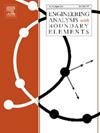Nonlinear generalized piezothermoelasticity of spherical vessels made of functionally graded piezoelectric materials
IF 4.2
2区 工程技术
Q1 ENGINEERING, MULTIDISCIPLINARY
Engineering Analysis with Boundary Elements
Pub Date : 2024-10-30
DOI:10.1016/j.enganabound.2024.106010
引用次数: 0
Abstract
The present study investigates the thermoelastic response of a heterogeneous piezoelectric sphere under thermal shock loading. Boundary conditions as well as loading are considered as symmetric; thus, the response of the sphere is expected to be symmetric. All of the properties of the thick-walled sphere, including mechanical, electrical and thermal properties, are considered dependent on the radial position, except for the relaxation time, which is considered a constant value along the radius. The governing equations of the sphere have been derived under heterogeneous anisotropic assumptions. The general form of the second law of thermodynamics, which is nonlinear in nature, and is called nonlinear energy equation is used. The number of the established equations is three, which includes the motion equation, energy equation and Maxwell electrostatic equation of Maxwell. These equations are obtained in terms of radial displacement, temperature difference and electric potential. The energy equation is derived based on Lord and Shulman theory with a single relaxation time. In the next step, by introducing dimensionless variables, the governing equations are provided in dimensionless presentation. Then these equations have been discretized using generalized differential quadrature method. Also, in order to follow the solution of the equations in time domain, Newmark method has been used. Since the system of equations is nonlinear, Picard algorithm is applied as a predictor-corrector mechanism to solve the nonlinear system of equations. Then numerical results are presented to investigate the propagation of mechanical, thermal and electric waves inside the heterogeneous sphere and also their reflection from the outer surface of the sphere. By examining the results, it can be seen that mechanical and thermal waves propagate with a limited speed, while the speed of electric wave propagation is infinite.
由功能分级压电材料制成的球形容器的非线性广义压热弹性
本研究探讨了异质压电球在热冲击加载下的热弹性响应。边界条件和加载被认为是对称的,因此球体的响应预计也是对称的。厚壁球体的所有特性,包括机械、电气和热特性,都被认为与径向位置有关,但弛豫时间除外,它被认为是沿半径的恒定值。球体的控制方程是在异质各向异性假设下推导出来的。热力学第二定律的一般形式在本质上是非线性的,被称为非线性能量方程。建立的方程有三个,包括运动方程、能量方程和麦克斯韦静电方程。这些方程是根据径向位移、温差和电动势得到的。能量方程是根据 Lord 和 Shulman 理论,在单一弛豫时间下导出的。下一步,通过引入无量纲变量,以无量纲形式给出了控制方程。然后使用广义微分正交法对这些方程进行离散化。此外,为了跟踪方程在时域中的求解,还使用了纽马克方法。由于方程组是非线性的,因此采用了 Picard 算法作为预测-修正机制来求解非线性方程组。然后给出了数值结果,以研究机械波、热波和电波在异质球体内部的传播,以及它们从球体外表面的反射。研究结果表明,机械波和热波的传播速度是有限的,而电波的传播速度是无限的。
本文章由计算机程序翻译,如有差异,请以英文原文为准。
求助全文
约1分钟内获得全文
求助全文
来源期刊

Engineering Analysis with Boundary Elements
工程技术-工程:综合
CiteScore
5.50
自引率
18.20%
发文量
368
审稿时长
56 days
期刊介绍:
This journal is specifically dedicated to the dissemination of the latest developments of new engineering analysis techniques using boundary elements and other mesh reduction methods.
Boundary element (BEM) and mesh reduction methods (MRM) are very active areas of research with the techniques being applied to solve increasingly complex problems. The journal stresses the importance of these applications as well as their computational aspects, reliability and robustness.
The main criteria for publication will be the originality of the work being reported, its potential usefulness and applications of the methods to new fields.
In addition to regular issues, the journal publishes a series of special issues dealing with specific areas of current research.
The journal has, for many years, provided a channel of communication between academics and industrial researchers working in mesh reduction methods
Fields Covered:
• Boundary Element Methods (BEM)
• Mesh Reduction Methods (MRM)
• Meshless Methods
• Integral Equations
• Applications of BEM/MRM in Engineering
• Numerical Methods related to BEM/MRM
• Computational Techniques
• Combination of Different Methods
• Advanced Formulations.
 求助内容:
求助内容: 应助结果提醒方式:
应助结果提醒方式:


